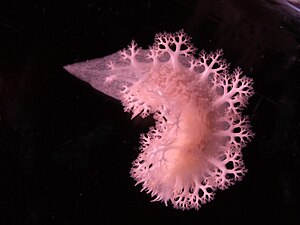Sapling snails
| Sapling snails | ||||||||||||
|---|---|---|---|---|---|---|---|---|---|---|---|---|

|
||||||||||||
| Systematics | ||||||||||||
|
||||||||||||
| Scientific name of the partial order | ||||||||||||
| Dendronotida | ||||||||||||
| Odhner , 1934 | ||||||||||||
| Scientific name of the superfamily | ||||||||||||
| Tritonioidea | ||||||||||||
| Lamarck , 1809 |
The sapling snails (Tritonioidea) are a superfamily and at the same time a suborder (Dendronotida) of the nudibranch within the order hindgill snails . The small to large caseless snails that occur in all oceans are carnivores that feed on various sessile and pelagic animals, mostly cnidarians .
features
Like other nudibranch snails, tree snails lack a shell and shell. The tree snails usually have two rows of branched appendages on their backs, which in many species appear like tree tops or aquatic plants due to their extensive branching and thus blur the contours of the snail. The rhinophores can be withdrawn into special sheaths. The mouth is surrounded by a velum (sail), which in the Tritoniidae and Dendronotidae carries a pair of sensor-like, tree-like branched appendages. The anus, like the heart, is on the right side.
The tree snails are hermaphrodites that mate with each other with their penises . Every animal produces eggs and sperm and has both a female and a male genital opening that are next to each other. The eggs are laid in clusters of thousands of egg capsules, from which Veliger larvae hatch. During their pelagic phase, these occasionally carry a tiny shell that is later lost, so that the metamorphosis creates a shell -less slug.
The tree snails are for the most part benthic and in most cases live on the plant-like sessile animals on which they feed and where they are camouflaged by their branched appendages. As a rule, especially in the case of the Tritoniidae and Dendronotidae , these are sessile cnidarians , especially hydrozoans . The snails of the genus Melibe in the family Tethydidae live on aquatic plants or on the sea floor, where they use their veil to prey on small crabs and jellyfish . The veil snail ( Tethys fimbria ), which belongs to the same family, is pelagic and also catches small crabs with its veil. The phylliroidae live as young as parasites of pelagic Hydrozoen, as well as pelagic adult animals they prey on cnidarians and various zooplankton .
Systematics
According to Bouchet and Rocroi (2005) the tree snails (Dendronotida) with the only superfamily Tritonioidea belong to nine families. A few species examples are also given:
- Family Tritoniidae Lamarck, 1809
- Great Tritonia ( Tritonia hombergi )
- Fringed tree snail ( Marionia blainvillea )
- Family Aranucidae Odhner, 1936
- Bornellidae Bergh family , 1874
- Family Dendronotidae Allman, 1845
- Shaggy tree snail ( Dendronotus frondosus )
- White sapling snail ( Dendronotus albus )
- Giant sapling snail ( Dendronotus iris )
- Family Hancockiidae MacFarland, 1923
- Lomanotidae Bergh family , 1890
- Phylliroidae Menke family , 1830
- Hatchet snail ( Phylliroe bucephala )
- Family Scyllaeidae Alder & Hancock, 1855
- Family Tethydidae Rafinesque, 1815
- Veil snail ( Tethys fimbria )
- Lion's head snail ( Melibe leonina )
- Melibe viridis
literature
- Luise Schmekel, Adolf Portmann: Opisthobranchia of the Mediterranean: Nudibranchia and Saccoglossa . Springer-Verlag, Berlin Heidelberg New York 1982. Subordo Dendronotacea Odhner, 1934 : pp. 141-171.
- Adam Sedgwick, Joseph Jackson Lister, Sir Arthur Everett Shipley: A Student's Text-book of Zoology: Protozoa to Chaetognatha . S. Sonnenschein and Company, 1898. Tritonioidea : p. 411.
- Philippe Bouchet & Jean-Pierre Rocroi: Part 2. Working classification of the Gastropoda . Malacologia, 47: 239-283, Ann Arbor 2005, ISSN 0076-2997 .
- Rudie H. Kuiter , Helmut Debelius : Nudibranchs of the world's oceans: 1200 species worldwide. Kosmos Verlag, Stuttgart 2007. ISBN 3-440-11133-4 .